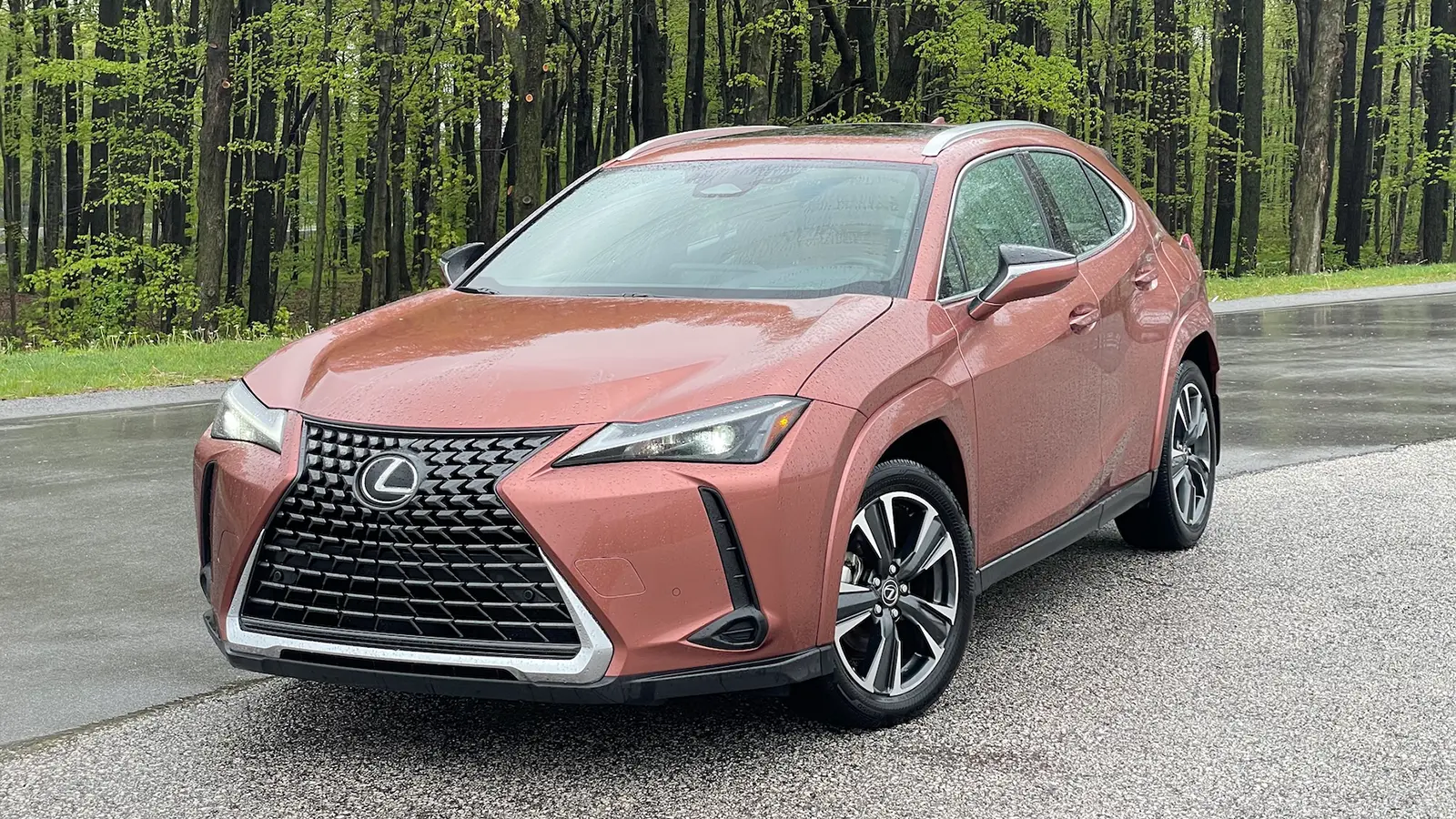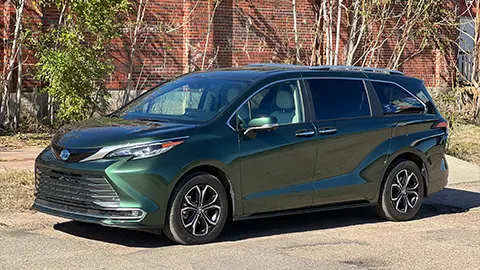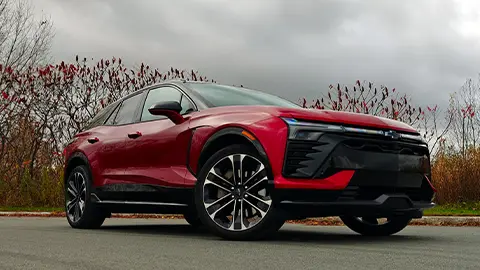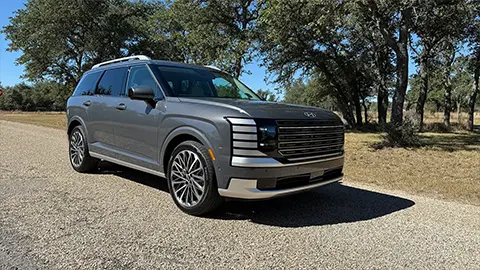Lexus tried this before. From 2011 to 2017, Toyota's luxury brand built a Lexus version of the Prius known as the CT 200h. But that car didn't make a lot of sense. It was a hatchback sold in a country that shuns them, it wasn’t nearly as efficient as the Prius, it was drastically underpowered, and it was rather expensive.
Maybe this time will be different. With the 2025 Lexus UX 300h, Lexus is once again offering a Prius of its own. However, the UX has already been established as the brand’s subcompact crossover. It’s also slightly more efficient than the CT 200h and much more powerful. As for the price, well, that’s still a bit high, but maybe the UX’s updates justify the price.
I spent a week with the UX 300h to learn the answer, and I found that Lexus’ version of the Prius is more appealing this time around.
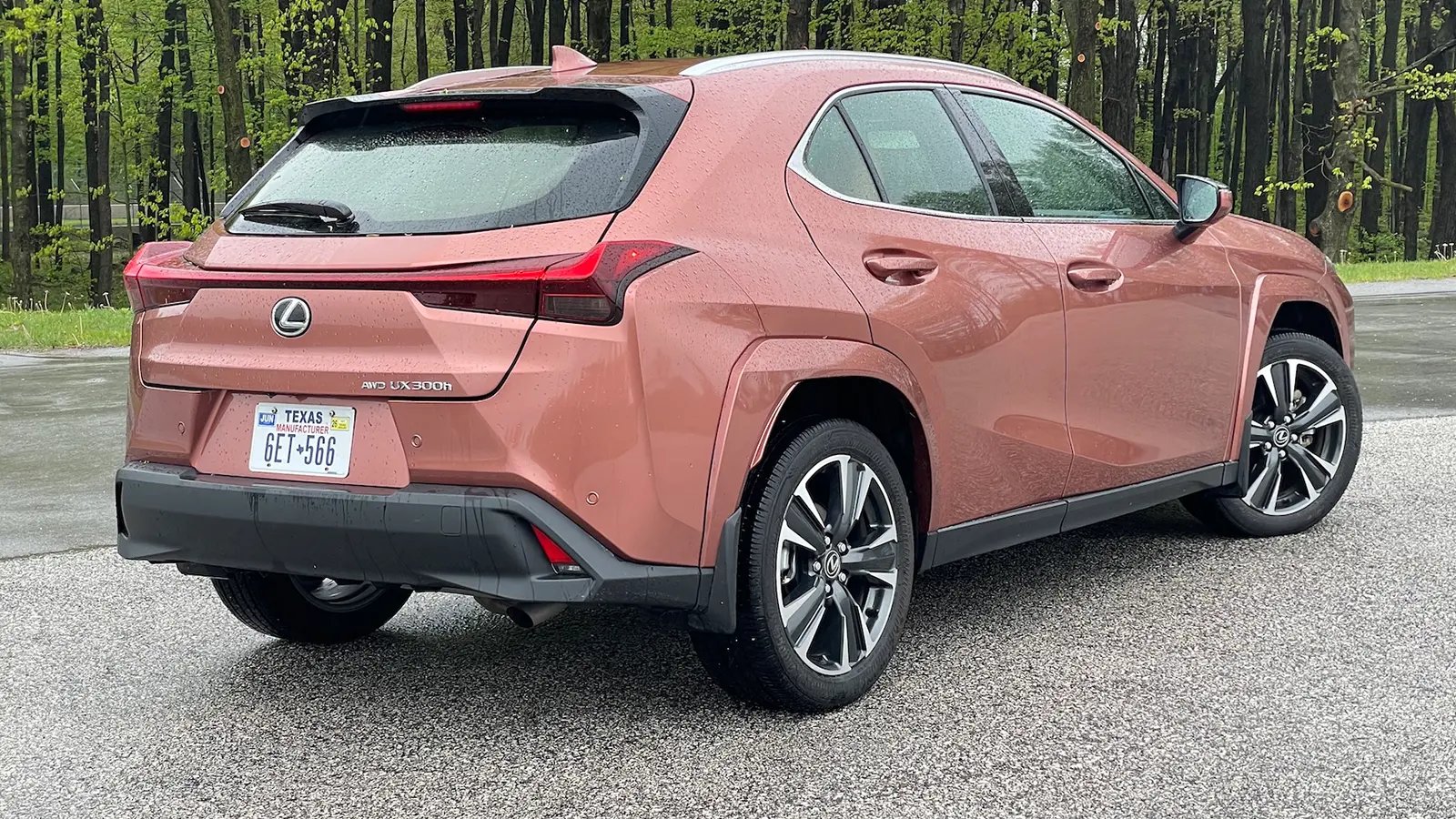
Quick Takeaways
- Power: 196-hp hybrid powertrain (up from 181 hp in previous UX 250h)
- Efficiency: 44 mpg city, 40 highway, 42 combined (AWD)
- Design: Subcompact crossover styling with hatchback practicality
- Platform: Toyota TNGA-C architecture shared with Prius
- Pricing: Premium-priced starting at $37,715, rising quickly with options
Prius Hybrid Powertrain
The UX 300h uses the same hybrid powertrain as the current Prius. It teams a 2.0-liter Atkinson-cycle four-cylinder gasoline engine with either two electric motor generators for front-wheel drive or three for all-wheel drive. A lithium-ion battery powers the motors, and the total system output is 196 horsepower. The CT 200h only had 134 horsepower.
Since 2023, the UX has only been offered as a hybrid, but this year’s output represents a step up. The fourth-generation hybrid system in the UX 250h made 181 horsepower, and this fifth-generation version gives the UX a needed kick of power. It’s still not strong, but with a Lexus-quoted 0-60 mph time of 7.9 seconds, it feels more appropriate for this premium small crossover.
Power flows through a planetary gearset-type continuously variable automatic transmission. Like in other Toyota hybrids, it has a slushy feel. It ramps up as the gear ratios change, rather than stepping up like with a standard automatic transmission. Dig deep into the power to get up to speed on the freeway or to pass at higher speeds, and the UX’s powertrain can drone. You’ll barely notice it in everyday traffic, though.
An EV mode lets owners drive on electric power alone, but it's intended only for short-range, lower-speed use. Lexus cites using it in parking garages, not on the street.
Efficient Little Runabout
While the UX’s power is limited, it’s quite efficient. With front-wheel drive, it earns EPA fuel-economy ratings of 45 mpg city, 41 highway, and 43 combined. Opt for the all-wheel-drive version, like my Copper Crest-painted tester, and those ratings fall slightly to 44/40/42 mpg. The UX beats the old CT 200h by 1 mpg, and like its predecessor, it’s much less efficient than the Prius, which now offers up to 57 mpg combined.
However, luxury-brand rivals like the BMW X1 and Mercedes-Benz GLA-Class can’t meet those numbers because they don’t currently offer hybrid models. Those vehicles top out at 28 and 29 mpg combined, respectively.
Curious how hybrids stack up against pure electrics? Check out our interactive tool: EV Matchmaker.
The UX 300h’s EPA numbers mostly hold in the real world. According to the trip odometer, I averaged 39.1 mpg over 188 miles of mostly highway driving.
Car or Crossover?
Like the Prius, the UX uses Toyota’s TNGA-C platform. This vehicle architecture uses high-strength steel, adhesives, and laser-screw welds. To keep weight in check, aluminum is used for the doors, fenders, and hood, while the tailgate is made of composite materials. The suspension employs MacPherson struts up front and double wishbones in the rear, the latter a premium feature.
At 6.3 inches off the ground, the UX sits only slightly higher than the Prius, which has ground clearances of 5.6 or 6.0 inches, depending on the model. A typical SUV sits about eight inches off the ground, so the UX's measurements provide a car-like stance.
The car-like quality is what I liked most about it. With a 104-inch wheelbase and a 177-inch overall length, it’s small. That ground clearance gives it a low center of gravity, just 23.4 inches high, and it weighs in at just 3,575 pounds, less than a BMW 3 Series.
Without too much vehicle to toss around, the UX handles well. The steering has some nice heft and is direct, even if responses are a bit slow. Toss it into a corner aggressively, and it pushes a little, but let off the throttle and the rear end comes around nicely. I expected a lot more understeer without the nifty recovery.
It rides well, too, on its standard 18-inch wheels and tires. The suspension is soft enough to soak up most bumps, though the short wheelbase means broken pavement makes the ride choppy. Overall, the UX isn’t sporty, but it's pleasingly controlled, like a well-tuned sedan.
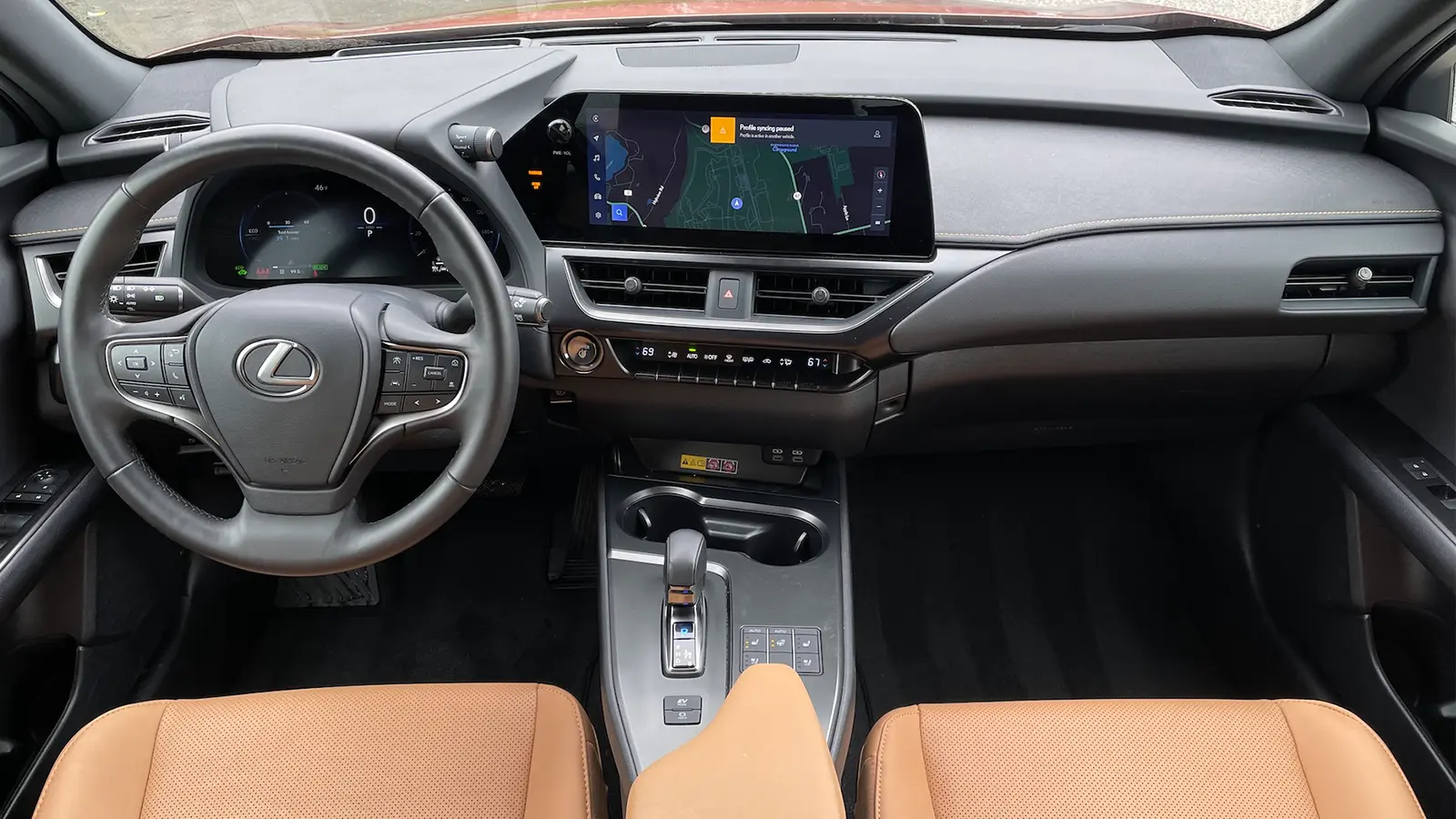
Cramped but Upscale Cabin
The view of the cockpit from the driver’s seat is the UX’s other strength. While Lexus upholsters the seats in synthetic leather rather than the real thing, it looks good. The Palomino (tan) and black color scheme of my tester’s interior worked well with the Copper Crest exterior and felt upscale. Eight-way power adjustments for the front seats come standard, and the Premium trim adds heated and ventilated front seats.
Moving up to the Premium trim also brings a standard 12.3-inch digital instrument cluster (instead of a 7.0-inch version) with sporty-looking graphics, and my tester had the optional 12.3-inch infotainment touchscreen that I would absolutely recommend over the standard 8.0-inch unit. It’s a pricey upgrade at $1,405, but it comes with cloud-based navigation and Lexus’ Intelligent Assistant that permits control of various vehicle functions using the “Hey Lexus” voice command.
The UX’s small size limits passenger and cargo space. The front seat is the place to be as it has good room for adults, and the power adjustments have enough range of motion for most people to dial in a comfortable seating position.
Two adults will fit in the back seat, but with just 33.1 inches of rear leg room (think Economy seating), anyone taller than average will either cut into it or complain vociferously about the lack thereof. Three across in the back is basically a nonstarter for adults, but kids could do it.
Cargo space is disappointing. Although Lexus says the lithium-ion battery is below the rear seat, the cargo floor still sits too high. That limits cargo space to 17.1 cubic feet with the seats up. Those figures fall between a typical hatchback and a small crossover, another reason to think of the UX as a hatchback rather than a crossover SUV.
Premium Price
The 2025 Lexus UX 300h MSRP starts at $37,715, including an $1,175 destination charge. It’s sparsely equipped, but it does get a good set of driver-assistance features, including automatic emergency braking, lane-departure warnings, adaptive cruise control, blind-spot monitors, rear cross-traffic alerts, safe-exit alerts, and automatic high-beams.
Adding all-wheel drive costs $1,570 extra and moving up to the Premium AWD brings the total MSRP to $42,485. For that money, buyers get the larger instrument cluster, front seat heating and ventilation, a sunroof, a hands-free power liftgate, and parking sensors. With the larger touchscreen, a head-up display ($900), a digital key ($375), and some other options, my test vehicle cost $46,255. That’s about $13,000 more than a nicely equipped mid-range Prius, which is a healthy chunk of change. UX 300h buyers will choose it because they want the extra comfort and convenience features, as well as the prestige of the Lexus badge.
They'll also think they’re getting a crossover SUV with outstanding fuel economy teamed with usable power. They’ll be right about the latter, but this time around Lexus found a way to make a hatchback look just enough like a crossover to make it cool.
You Might Also Like
Hybrid vs. Electric: Which Is Right for You?
Dive deep into the key differences between hybrid and fully-electric vehicles and find out what fits your lifestyle best.
Read More ➜
A Primer on Public DC Fast Charging
Learn exactly how DC fast charging works, its benefits over Level 1 and 2 charging, and how to optimize your charging sessions.
Read More ➜
Benefits of Home Charging
Discover why most hybrid and EV owners choose home charging, the necessary equipment, and potential cost savings.
Read More ➜





